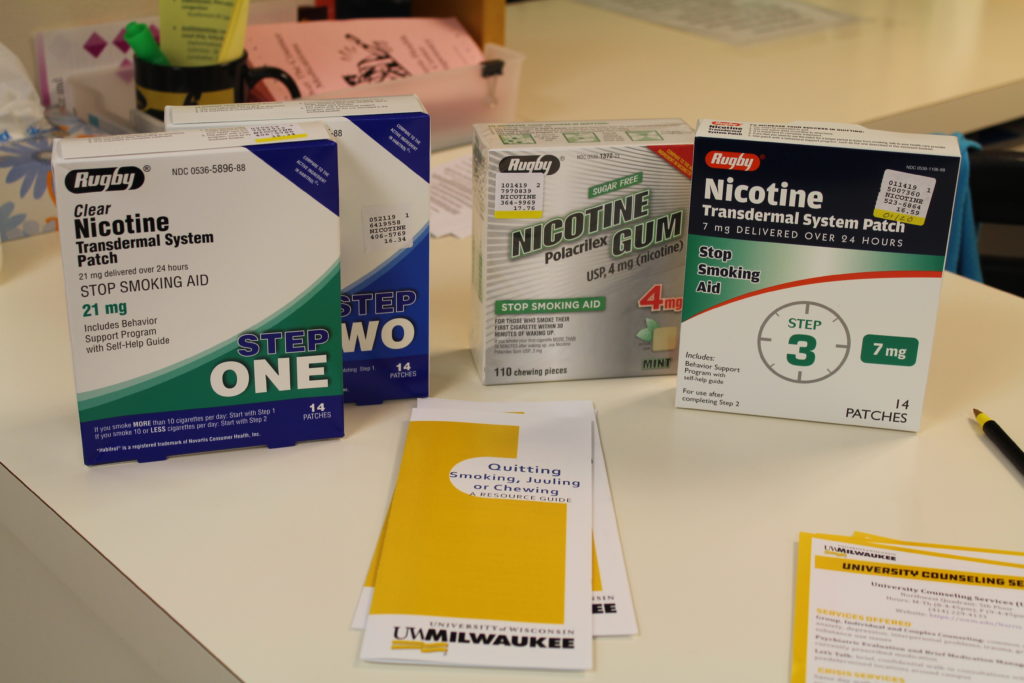UW-Milwaukee students do it while speed-walking to their next class, a cloud of smoke trailing behind them as they hurry along. While waiting at bus stops around campus, students casually raise a device that looks like a USB to their lips two or three times, slipping it into their pocket before getting on the bus. Before class, they do it behind Lubar Hall and in front of the library. And it is outside the library where UWM junior Adam Kelnhofer is doing it on a dreary October afternoon.
“I started vaping in 2018, I think in March, and I did it to quit smoking cigarettes,” says Kelnhofer. “I used to smoke a pack a day and I thought vaping would help me cut down on how much I smoke. And it actually has.”
Kelnhofer says he goes through a 5% Juul pod, which contains as much nicotine as a pack of cigarettes, in two to three days, and he feels better.
“I feel less congested, my lungs don’t feel as taxed and I don’t have nearly as much mucus or snot,” says Kelnhofer.
According to a 2018 survey of UWM students, 28% had used an electronic vapor product in the last 30 days, which is double the number of students who said they used traditional cigarettes. And in the United States, vaping by college students rose from 6% to 15% from 2017 to 2018, according to a survey of college students conducted by Monitoring the Future. It is the largest proportional increase for a substance in the 40 years the survey has been conducted.
Norris Health Center Clinical Director Dr. Aamir Siddiqi says students like Kelnhofer who vape to quit smoking don’t realize just how harmful nicotine is to their bodies.

“Many of our younger population have considered vaping to be a safer alternative to smoking, and some of them have even using them to quit,” says Dr. Siddiqi. “But what they have failed to realize is that vaping still contains nicotine and has the same addictive qualities as smoking.”
A major reason why students are drawn to vaping besides help in quitting cigarette use is trying it with friends who vape, says Zach Weaver, a manager at Milwaukee Vapor, a vape shop located near campus.
“I do have a lot of people come in saying, ‘Oh my friends had one of these, do you have the same thing?’” says Weaver.
Weaver believes students prefer vaping to smoking because it’s easier.
“People like the idea of a quick smoke that doesn’t smell, it doesn’t linger,” says Weaver. “You can get a quick buzz from it. People can be really slick about it.”
Public health experts at UWM say a major reason why students start vaping is pressure from friends and exposure to advertisements from vaping companies.
“The strongest factor in the initiation of tobacco use is peer pressure,” says Dr. Seok Hyun (Joshua) Gwon, associate professor at the UWM College of Nursing. “ We need to think about the friendly environmental factors, they are everywhere these days. It is easy to see advertisements or digital images and texts on social media and in retailers.”

Meanwhile, UWM does have a smoke and tobacco-free policy on campus that prohibits the use of e-cigarette. Implemented last fall, it replaced a previous smoke-free policy that did not include e-cigarettes. Lawn signs advertising it are planted across campus, on every campus building, and in spots where smoking and vaping were especially popular like “smoking valley,” an area between the library and student union where people smoked and vaped heavily before the policy was put in place.
Photos: John Gomes
One UWM student vaper who didn’t want her name used says she doesn’t feel the policy is effective.
We are all adults, we’re all over 18. If I’m paying 7-10 grand a semester, I should be able to do what I want.
UWM student vaper
“I still see people regularly vaping, including myself,” she says. The student says she is more careful about staying away from others while vaping on campus, but she feels that UWM shouldn’t be able to regulate what she does on campus.
“We are all adults, we’re all over 18. If I’m paying 7-10 grand a semester I should be able to do what I want,” she says.
Other student vapers weren’t even aware that the policy included e-cigarettes. Joey, a UWM sophomore, did not know the policy included products like Juul.
“ I just thought it said tobacco-and-smoke free campus, it should say vaping,” says Joey.
Weaver says that students who visit his shop aren’t worried about the policy. He wasn’t even aware of it.
Sales at Milwaukee Vapor have in fact increased among students, who are stocking up in case of a ban on vaping products, says Weaver.
Dr. Yang Wang, an associate professor at the Zilber School of Public Health at UWM, co-authored a study with Dr. Gwon of student opinions on vape-free campus policies. He says that college students are more likely to oppose bans like the one at UWM.
“It also depends on how you perceive the risk of electronic cigarettes. If you think they are less harmful, you are more likely to oppose a vape-free campus,” says Dr. Wang.
Dr. Siddiqi is aware of the number of students vaping on campus in spite of the policy and wants to increase awareness of the negative effects of vaping.
“I see ads on television, on those closed-circuit TVs that are running on campus, maybe one of the ads should be, have you considered quitting vaping?” says Dr. Siddiqi.

Meanwhile, Dr. Gwon and Dr. Yang support the policy because it limits second-hand smoke and deters people from becoming first-time tobacco users.
“Under this new campus policy, tobacco use can be controlled,” says Dr. Gwon. “More importantly, this campus policy will be beneficial for non-tobacco users. I think this is the right time to talk about the potentially detrimental effects about second-hand vaping. Its effect has not been fully understood.”
According to Dr. Gwon, the vapor exhaled isn’t just water. Researchers have shown that the vapor contains chemicals like formaldehyde, a known carcinogen.
Dr. Gwon says the policy will help make students and faculty aware of how similar vaping and tobacco products are.
“I believe this policy will help the general campus population including faculty, staff and students recognize that e-cigarettes are tobacco products,” he says. “This is another important thing we should not overlook. This way this new policy will work for all of us.”
UWM police say that for now, students found vaping on campus will be given a warning and an educational card that directs them to this website. The focus of the policy is education, but if the number of students vaping on campus escalates, UWM police say fines will be given out.
Students who want to quit vaping have options at Norris Health Center.
“Our providers are experienced with nicotine addiction in many different ways,” says Dr. Siddiqi. “ We have dedicated appointments that students can make that go over vaping and tobacco addiction. There is an initial session that assesses their readiness and their triggers, and then a follow up session when medications can be given that are given for tobacco and nicotine addiction.”
Those medications, according to Dr. Siddiqi, are cheaper for students at Norris than at outside pharmacies.

Kelnhofer says he would like to quit vaping, but there are obstacles keeping him from doing so.
“I think going cold turkey would introduce too much stress at this point and I want to focus on school.”




